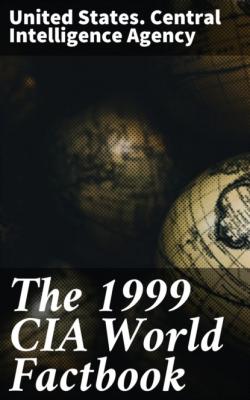The 1999 CIA World Factbook. United States. Central Intelligence Agency
Чтение книги онлайн.
Читать онлайн книгу The 1999 CIA World Factbook - United States. Central Intelligence Agency страница 152
 total population: 94.8%
total population: 94.8%male: 94.7%
female: 95% (1995 est.)
Government
Country name:
conventional long form: Republic of Costa Rica
conventional short form: Costa Rica
local long form: Republica de Costa Rica
local short form: Costa Rica
Data code: CS
Government type: democratic republic
Capital: San Jose
Administrative divisions: 7 provinces (provincias, singular—provincia); Alajuela, Cartago, Guanacaste, Heredia, Limon, Puntarenas, San Jose
Independence: 15 September 1821 (from Spain)
National holiday: Independence Day, 15 September (1821)
Constitution: 9 November 1949
Legal system: based on Spanish civil law system; judicial review of legislative acts in the Supreme Court; has not accepted compulsory ICJ jurisdiction
Suffrage: 18 years of age; universal and compulsory
Executive branch:
chief of state: President Miguel Angel RODRIGUEZ (since 8 May 1998);
First Vice President Astrid FISCHEL Volio (since 8 May 1998), Second
Vice President Elizabeth ODIO Benito (since 8 May 1998);
note—president is both the chief of state and head of government
head of government: President Miguel Angel RODRIGUEZ (since 8 May
1998); First Vice President Astrid FISCHEL Volio (since 8 May 1998),
Second Vice President Elizabeth ODIO Benito (since 8 May 1998);
note—president is both the chief of state and head of government
cabinet: Cabinet selected by the president
elections: president and vice presidents elected on the same ticket
by popular vote for four-year terms; election last held 1 February
1998 (next to be held NA February 2002)
election results: Miguel Angel RODRIGUEZ elected president; percent
of vote—Miguel Angel RODRIGUEZ (PUSC) 46.6%, Jose Miguel CORRALES
(PLN) 44.6%
Legislative branch: unicameral Legislative Assembly or Asamblea
Legislativa (57 seats; members are elected by direct popular vote to
serve four-year terms)
elections: last held 1 February 1998 (next to be held NA February
2002)
election results: percent of vote by party—PUSC 41%, PLN 35%,
minority parties 24%; seats by party—PUSC 27, PLN 23, minority
parties 7
Judicial branch: Supreme Court (Corte Suprema), justices are
elected for eight-year terms by the Legislative Assembly
Political parties and leaders: Social Christian Unity Party or
NA]
note: mainly a two-party system—PUSC and PLN; numerous small parties
share less than 25% of population's support
Political pressure groups and leaders: Costa Rican Confederation
of Democratic Workers or CCTD (Liberation Party affiliate);
Confederated Union of Workers or CUT (Communist Party affiliate);
Authentic Confederation of Democratic Workers or CATD (Communist
Party affiliate); Chamber of Coffee Growers; National Association
for Economic Development or ANFE; Free Costa Rica Movement or MCRL
(rightwing militants); National Association of Educators or ANDE;
Federation of Public Service Workers or FTSP
International organization participation: BCIE, CACM, ECLAC, FAO,
G-77, IADB, IAEA, IBRD, ICAO, ICFTU, ICRM, IDA, IFAD, IFC, IFRCS,
ILO, IMF, IMO, Inmarsat, Intelsat, Interpol, IOC, IOM, ISO, ITU,
LAES, LAIA (observer), NAM (observer), OAS, OPANAL, OPCW, UN, UN
Security Council (temporary), UNCTAD, UNESCO, UNIDO, UNU, UPU, WCL,
WFTU, WHO, WIPO, WMO, WToO, WTrO
Diplomatic representation in the US:
chief of mission: Ambassador Jaime DAREMBLUM
chancery: 2114 S Street NW, Washington, DC 20008
consulate(s) general: Albuquerque, Atlanta, Chicago, Durham,
Houston, Los Angeles, Miami, New Orleans, New York, Philadelphia,
San Antonio, San Diego, San Francisco, San Juan (Puerto Rico), and
Tampa
consulate(s): Austin
Diplomatic representation from the US: chief of mission: Ambassador Thomas J. DODD embassy: Pavas Road, San Jose mailing address: APO AA 34020
Flag description: five horizontal bands of blue (top), white, red (double width), white, and blue, with the coat of arms in a white disk on the hoist side of the red band
Economy
Economy—overview: Costa Rica's basically stable economy depends on tourism, agriculture, and electronics exports. Poverty has been substantially reduced over the past 15 years and a strong social safety net has been put into place. Economic growth has rebounded from −0.9% in 1996 to 3% in 1997 and an estimated 5.5% in 1998. Inflation rose to 22.5% in 1995, dropped to 11.1% in 1997, and reached an estimated 12% in 1998. Unemployment appears moderate at 5.6%, but substantial underemployment continues. Furthermore, large government deficits—fueled by interest payments on the massive internal debt—have undermined efforts to maintain the quality of social services. Curbing inflation, reducing the deficit, and improving public sector efficiency remain key challenges to the government. President RODRIGUEZ has called for an increased economic role for the private sector, but political resistance to privatization has stalled much of his economic program.
GDP: purchasing power